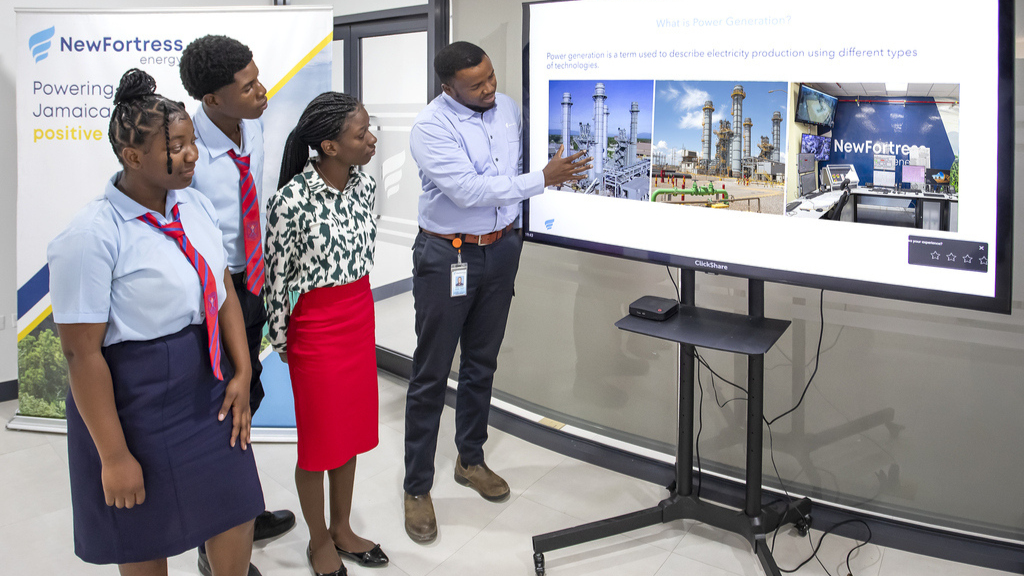New Fortress Energy tours boost Konx students’ exam prep | Loop Jamaica
New Fortress Energy tours boost Konx students' exam prep | Loop Jamaica Loop News Jamaica


Industrial Tours at New Fortress Energy Facilities Prepare High School Students for Examinations
With CSEC and CAPE examinations in progress, high school students are busy burning the proverbial midnight oil studying while teachers are pulling out all the stops to ensure that their students have all the materials and resources needed to put their best foot forward.
One such resource that several rural high schools have been taking advantage of is industrial tours at New Fortress Energy’s liquefied natural gas facilities in preparation for their upcoming electrical engineering and environmental science examinations.
Touring the Combined Heat and Power Plant (CCHP)
More than 50 CSEC and CAPE students, along with their teachers from Alphansus Davis High School, Knox College, and Old Harbour High School, toured the company’s Combined Heat and Power Plant (CCHP) in Clarendon recently to get a practical understanding of the various stages of power generation, energy conversion, the use of steam in energy production, and the environmental benefits of natural gas.
Enhancing Learning Outside the Classroom
Anthony Norman, geography and environmental science teacher at Knox College, said tours like these give students a great opportunity to learn outside of the classroom.
“This tour was a very fitting summary of the discussions we’ve had in class. The students now have a practical understanding of the different forms of energy used to generate electricity across Jamaica. Importantly, we also have a greater appreciation for the role of natural gas in electricity generation through gas turbines. This has certainly been helpful, and I have no doubt that it will benefit the students greatly in their exams.”

Leonard Williams, Power Generation Engineer at NFE’s CCHP facility, in discussion with Sarah Brooks and Darren James – 12th grade environmental science students from Knox College, while Kasia Richardson from the Humanities department looks on.
Old Harbour High School electrical engineering teacher, Ingrid Dillon, added, “The presentations covered the objectives that were requested and based on how the students answered the questions that were posed to them, it’s clear that they were well engaged and grasped the concept of power generation using natural gas.”
Meanwhile, Janet Raynor, environmental and integrated science teacher for grades seven to thirteen at Aphansus Davis High school, said, “This was a very interesting and informative tour. I have no doubt that the explanations and demonstrations will help all the students because energy conversion is a faucet of environmental science, and this was explained quite clearly during this tour and from the videos that were shown.”
New Fortress Energy’s Clarendon Combined Heat and Power Plant (CCHP)
Located in Hayes, Clarendon and commissioned in 2020, NFE’s 150MW Clarendon Combined Heat and Power plant (CCHP) is the first of its kind in the region. The gas-fired, co-generation plan supplies steam to the neighboring Jamalco bauxite facility, and approximately 100MW baseload power to the national grid.
Verona Carter, VP, New Fortress Energy, said; “STEM education is a powerful catalyst in achieving economic sustainability as it fosters innovation and equips individuals with the knowledge and skills to solve global issues. As the pioneer in Jamaica’s LNG sector, we are therefore proud to partner with these high schools to give students real-life exposure to the world of Liquified Natural Gas to help them prepare for their upcoming exams. At NFE, we are committed to continue playing our role in helping position Jamaica as a leader in the region as a forward-thinking country that has successfully diversified its energy sector with the addition of LNG.”
SDGs, Targets, and Indicators Analysis
1. Which SDGs are addressed or connected to the issues highlighted in the article?
- SDG 4: Quality Education
- SDG 7: Affordable and Clean Energy
- SDG 9: Industry, Innovation, and Infrastructure
- SDG 13: Climate Action
The article highlights the importance of education, particularly in the fields of electrical engineering, environmental science, and geography. It also discusses the use of natural gas as a source of energy and its environmental benefits. These issues are directly connected to SDG 4 (Quality Education), SDG 7 (Affordable and Clean Energy), SDG 9 (Industry, Innovation, and Infrastructure), and SDG 13 (Climate Action).
2. What specific targets under those SDGs can be identified based on the article’s content?
- SDG 4.3: By 2030, ensure equal access for all women and men to affordable and quality technical, vocational, and tertiary education, including university.
- SDG 7.2: By 2030, increase substantially the share of renewable energy in the global energy mix.
- SDG 9.5: Enhance scientific research, upgrade the technological capabilities of industrial sectors in all countries, in particular developing countries.
- SDG 13.2: Integrate climate change measures into national policies, strategies, and planning.
The article emphasizes the importance of providing equal access to quality education in technical fields like electrical engineering and environmental science. This aligns with SDG 4.3. The use of natural gas as a cleaner source of energy contributes to SDG 7.2, which aims to increase the share of renewable energy. The industrial tours also promote scientific research and technological capabilities, supporting SDG 9.5. Additionally, the focus on the environmental benefits of natural gas aligns with SDG 13.2, which calls for integrating climate change measures into national policies.
3. Are there any indicators mentioned or implied in the article that can be used to measure progress towards the identified targets?
- Number of students enrolled in technical and vocational education programs
- Percentage of renewable energy in the energy mix
- Investment in research and development in industrial sectors
- Integration of climate change measures in national policies and planning
The article does not explicitly mention specific indicators. However, progress towards the identified targets can be measured using indicators such as the number of students enrolled in technical and vocational education programs (related to SDG 4.3), the percentage of renewable energy in the energy mix (related to SDG 7.2), investment in research and development in industrial sectors (related to SDG 9.5), and the integration of climate change measures in national policies and planning (related to SDG 13.2).
SDGs, Targets, and Indicators Table
| SDGs | Targets | Indicators |
|---|---|---|
| SDG 4: Quality Education | 4.3: By 2030, ensure equal access for all women and men to affordable and quality technical, vocational, and tertiary education, including university. | Number of students enrolled in technical and vocational education programs |
| SDG 7: Affordable and Clean Energy | 7.2: By 2030, increase substantially the share of renewable energy in the global energy mix. | Percentage of renewable energy in the energy mix |
| SDG 9: Industry, Innovation, and Infrastructure | 9.5: Enhance scientific research, upgrade the technological capabilities of industrial sectors in all countries, in particular developing countries. | Investment in research and development in industrial sectors |
| SDG 13: Climate Action | 13.2: Integrate climate change measures into national policies, strategies, and planning. | Integration of climate change measures in national policies and planning |
Copyright: Dive into this article, curated with care by SDG Investors Inc. Our advanced AI technology searches through vast amounts of data to spotlight how we are all moving forward with the Sustainable Development Goals. While we own the rights to this content, we invite you to share it to help spread knowledge and spark action on the SDGs.
Fuente: jamaica.loopnews.com

Join us, as fellow seekers of change, on a transformative journey at https://sdgtalks.ai/welcome, where you can become a member and actively contribute to shaping a brighter future.







